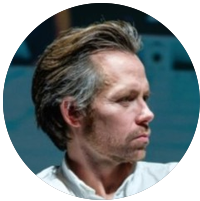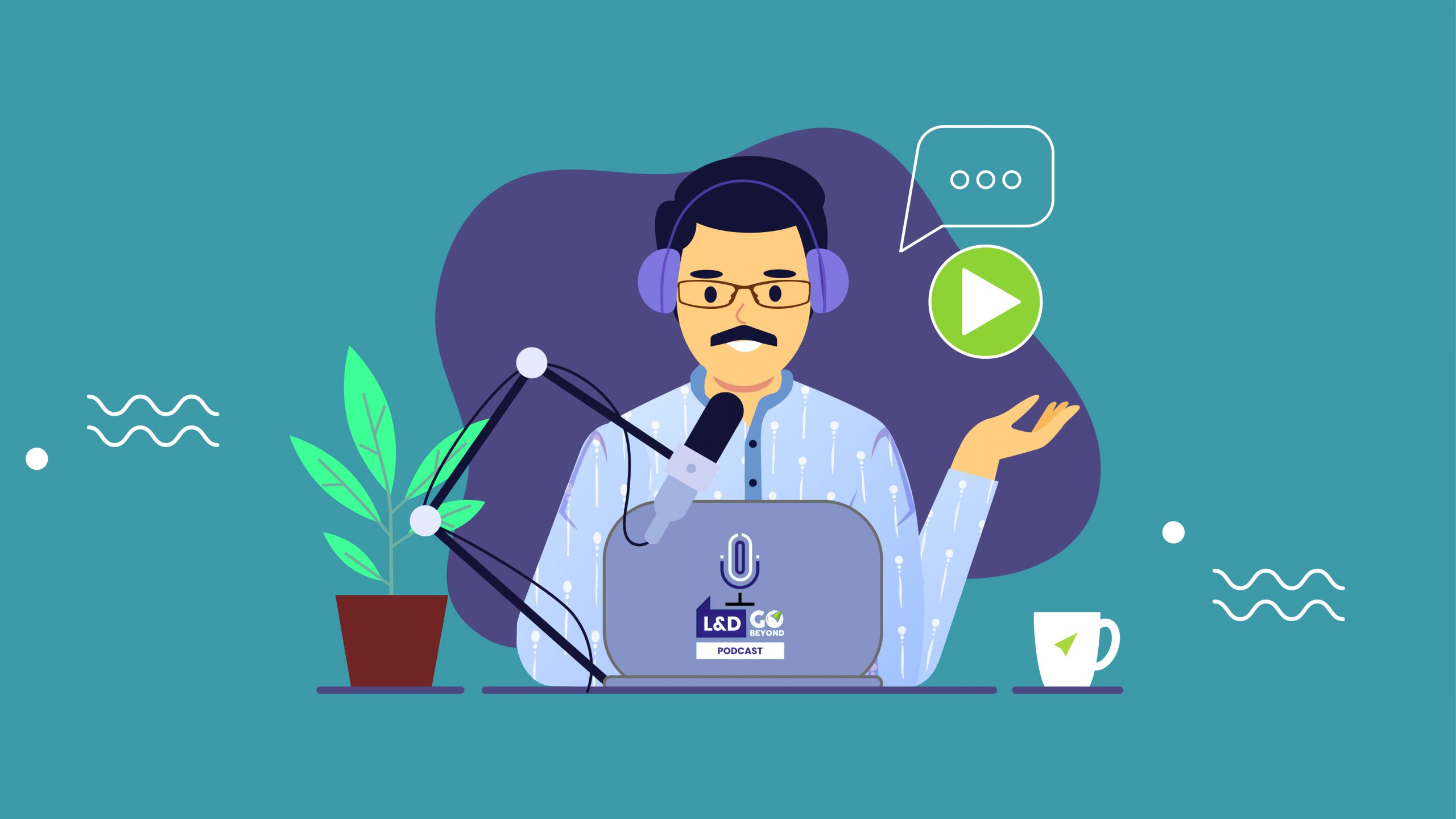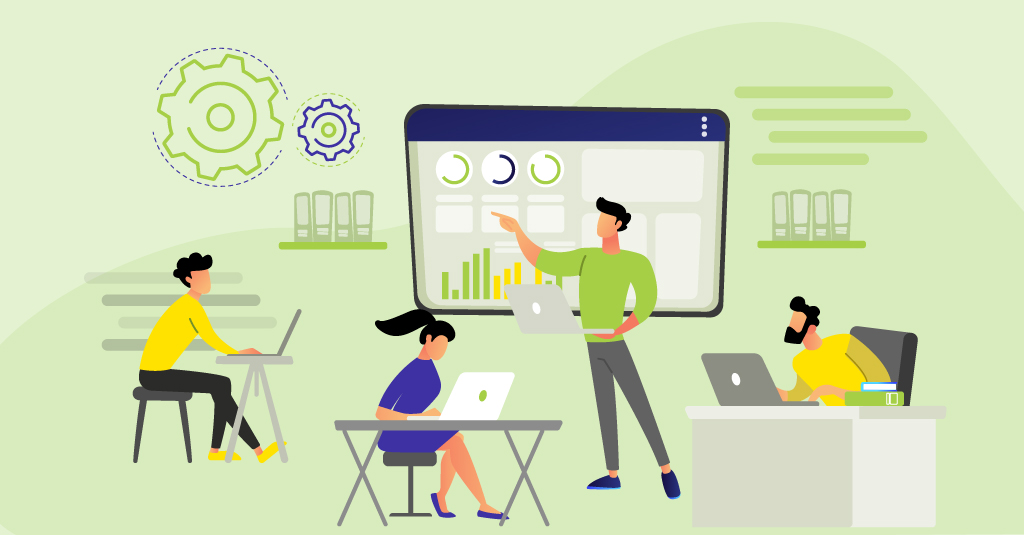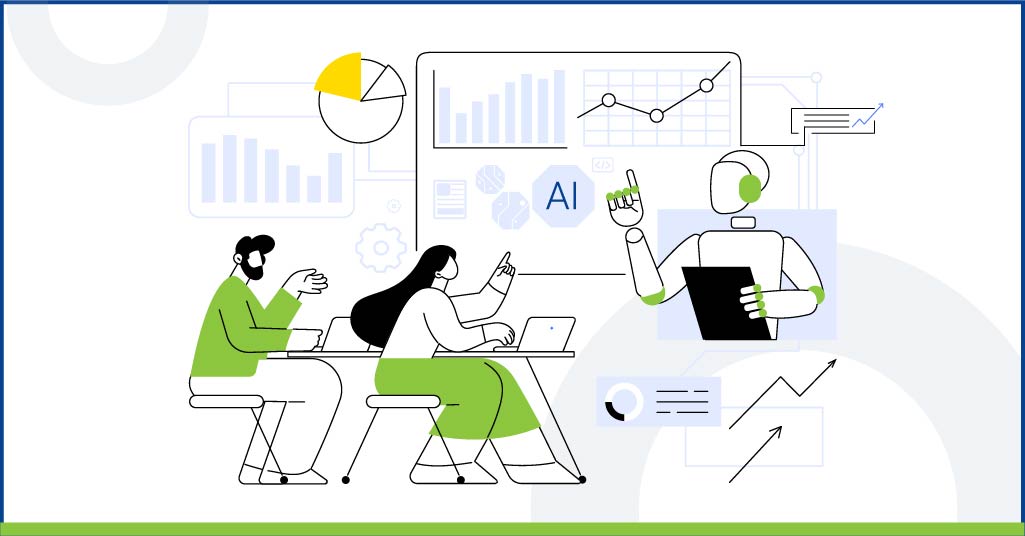In an attempt to enable L&D professionals to stay ahead and go beyond the ordinary, Upside Learning launched the L&D Go Beyond Podcast in August of 2021, and what a ride it has been! We explored a diverse range of topics that matter to the L&D community in more ways than one.
Season 1 of the Podcast aired 24 insightful episodes, with noteworthy guest speakers from around the world. While every episode will get you hooked on the knowledge and experiences that the speakers share, here’s giving you a quick recap of the season with the top insight from every one of the 24 episodes.
Episode 1: Learning Engagement in Supply Chain Training, with Dhiren Doshi

Dhiren Doshi
Solutions Architect | EnableOpEx LLC
Ex-Colgate-Palmolive
The podcast kicked off with its maiden episode with Dhiren Doshi. Dhiren expressed his staunch belief in leveraging capability in the most effective way. He emphasized the need for organizations to experiment so as to capitalize on the technologies such as AR and VR. Here is the top insight from the episode:
“Getting people to make a post-training action plan is a great way to increase learning transfer.” – Dhiren Doshi
Catch the entire episode here.
Episode 2: Building Learning Programs that Engage, with Kirk Donaghey

Standards and Frameworks Manager | Optus
In this episode, Kirk emphasized learning engagement while differentiating it from a learning experience. He expressed his interpretation of learning engagement as something deriving from the volume of engagement a session or a piece of learning is fetching. Below is the top insight from this episode:
“If a learning experience was high effort and low value, then that’s the expectation you place on that experience the next time you go there – high effort, low value.” – Kirk Donaghey
Catch the entire episode here.
Episode 3: Design Thinking for Learning Engagement, with Keith Keating

SVP, Chief Learning Officer | Archwell
Sharing his thoughts on learning engagement, Keith spoke about design thinking being a part of a larger family – the human-centric design family which also focuses on User Experience (UX) and Learner Experience (LX). Here is the top insight from this episode:
“The technology tools are tangible. It is easier to digest than to talk about learning sciences behavioral sciences, learning engagement, culture strategy, those are all the hard things.” – Keith Keating
Catch the entire episode here.
Episode 4: How to Bring Performance Focus to Training, with Guy W Wallace

President | EPPIC Inc.
This podcast episode saw Guy placing a heavy premium on performance focus. He shared his belief that learning should always be performance-oriented and focused on what the output is going to be. Providing food for thought is this top insight from his episode:
“Often, we assume that IF people have been trained, they will apply what they’ve learned. However, the tendency to revert to old ways of doing things is more common than we think. For sure it takes effort to change and is definitely much more comfortable to revert to old ways. We need to plan and build for that.” – Guy W Wallace
Catch the entire episode here.
Episode 5: Innovation in L&D, with Phil Reddall

Head of Learning (Desk) and Capability Systems | Thames Water
Phil discussed his analyses that the speed of change is only increasing, making innovation all the more important. In his view, innovation is very context-specific, so everyone will have a different version of what innovation looks like. Here is his top quote:
“Don’t make things efficient – in the name of innovation – if it negatively impacts effectiveness.” – Phil Reddall
Catch the entire episode here.
Episode 6: How to Solve the Right Problems in L&D, with Jennifer Tsang

Chief of Staff, Learning and Certifications | Cisco
While mentioning root-cause analysis in her discussion, Jennifer also strongly advocated for L&D’s role to go beyond just creating a typical training video. She suggested developing programs that offered more value and experience while looking at the role, organization, and culture together. This is the top quote from her episode:
“Make line managers L&D partners, as they are pivotal in influencing and adoptions. They understand the roles of their teams much better than L&D and help craft appropriate learning initiatives that solve real problems.” – Jennifer Tsang, PCC
Catch the entire episode here.
Episode 7: Curation & Learning Ecosystems – Dealing With the Complexity That Damages Learning Culture, with Toby Harris

Chief Marketing Officer | Filtered
In this episode, Toby suggested using data to decide on the most important skills for an organization, analyzing and filtering it to zero in on the relevant content, and delivering it via LXP or multi-channel campaign. According to him, this is where curation comes in. His top insight sheds light on this:
“If you are not going to make any content, you have no identity.” – Toby Harris
Catch the entire episode here.
Episode 8: Curiosity & Learning in the Workplace – Dealing With the Complexity That Damages Learning Culture, with Stefaan van Hooydonk

Founder | Global Curiosity Institute
This podcast episode saw Stefaan sharing his definition of curiosity as ‘the mindset to challenge the status quo; explore, discover, and learn. Workplace curiosity needs to be productive – start with a question, focus on getting an answer, and be disciplined enough to get there. Productive curiosity often leads to better exploitation as well as new exploration. Check the top insight from his episode:
“The more the leader learns, the more the team will learn.” – Stefaan van Hooydonk 范汇东
Catch the entire episode here.
Episode 9: Chatbots in Workplace Learning & Performance, with Vince Han

CEO / Founder | Mobile Coach
According to Vince, low engagement with learner audiences can be tackled through automated conversation or chatbots on mobile devices that offer a frictionless user experience. This can also generate endless possibilities to help solve L&D’s engagement problems. This is the top insight from this episode:
“Chatbots help Learning and Development meet the learners where they are.” – Vince Han
Catch the entire episode here.
Episode 10: Design for How People Learn, with Julie Dirksen

Learning Strategy Consultant | Usable Learning
Julie discussed various contextual points on memorization by learners and the recalling of these learnings when it comes to encoding and decoding, especially in this age of information overload. She also emphasized the importance of feedback in the digital learning environment. This is her top insight:
“People’s interest levels and therefore their motivation and ability to pay attention to learning content is entirely contingent on whether there’s something they can do with it right away.” – Julie Dirksen
Catch the entire episode here.
Episode 11: AI and The Upskilling Imperative for L&D, with Maria Leggett

Sr. Director of Learning and Development | AvidXchange, Inc.
In this episode, Maria spoke about the changes and impact that AI is having on L&D, how it will be completely reinvented, developing skill taxonomy, amongst other things. Here is the top insight from the episode:
“Data is a very powerful tool because as we get more expansive with it, it’s less biased”. – Maria Leggett
Catch the entire episode here.
Episode 12: Writing Better Multiple-Choice Questions to Assess Learning, with Patti Shank

President | Learning Peaks, LLC
According to Patti, people have certain misconceptions about multiple-choice questions, the biggest one being that a multiple-choice test can only assess recall. However, the main purpose of an MCQ test is to assess the learning objectives, and whether the people who took these courses are able to meet learning objectives and, if not, we need to fix these courses. On that note, below is the top insight of the episode:
“If we don’t know what people on the job need to be able to do, then we don’t know what to test.” – Patti Shank, PhD
Catch the entire episode here.
Episode 13: The ten questions you must ask at the start of any learning project, Joe Ganci

Owner | eLearning Joe
This podcast episode saw Joe essentially discussing every role in the learning industry, mainly for people in the decision-making areas. He highlighted that content, context, and storytelling are important aspects to envision learner engagement. Among his invaluable suggestions was this top insight:
“What we need to teach and what they need to learn is certainly important. But even more important is why they need to learn these things.” – Joe Ganci
Catch the entire episode here.
Episode 14: Learning for L&D Professionals, with Joti Joseph

Director, Talent and Learning | Vontobel
Joti’s opinion on learning for L&D professionals is like going back to the basics; something that comes out of ‘common sense’. It implies investing in one’s own capability, acting as a role model for learners and stakeholders, and reinforcing previous experience for the development of oneself as well as the L&D community. Following is the top insight from the episode:
“We as L&D need to go back to our own basics; consulting and asking the right questions is a skill that is never ever going to go out of fashion.” – Joti Joseph
Catch the entire episode here.
Episode 15: Workplace Learning in the Post-Covid World, with Sam Taylor, Jr. and Rick Housler

Sam Taylor
Senior Learning Specialists | The World Bank

Jr. and Rick Housler
Senior Learning Specialists | The World Bank
According to Sam and Rick, the biggest challenge in delivering learning programs during the pandemic was losing that physical presence. With the full hybrid model, it has added another challenge for the instructors to not fall back on the old habits. Read the top insight from the episode below:
“With digital learning, being respectful of people’s time is so important to make it motivational and ultimately useful. It is very easy to lose sight of this when the SME wants ALL THE CONTENT to be dumped in that learning program.” – Sam Taylor, Jr. and Rick Housler
Catch the entire episode here.
Episode 16: Gamifying Workplace Learning the Right Way, with Karl Kapp

Professor of Instructional Technology | Bloomsberg University
Gamification, in Karl’s opinion, allows L&D professionals to be transparent with what is being evaluated, how it is being evaluated, and what the learning goals are. So, gamification can be very helpful and motivating if the parameters are reasonable and decided upon in consultation with the learners themselves. Here is the top insight from this episode:
“When we gamify the outcomes (some) people tend to try and game the system.” – Karl Kapp
Catch the entire episode here.
Episode 17: Instructional Story Design, with Rance Greene

Founder and Story Designer | needastory.com
Rance talked about how stories work well in workplace learning due to their capability to prepare us for a situation and to act in the real world. The purpose of story design is to fill the gap between story and action. This is the top insight from his episode:
“The fact that we are somewhat emotionally averse in corporate settings is one of the reasons stories are not as welcomed.” – Rance Greene
Catch the entire episode here.
Episode 18: Challenges and Opportunities for Measuring the Impact of Training and Learning, with Kevin M. Yates

The L&D Detective
Founder and President | Meals in the Meantime
Kevin raised an important point in this discussion, which was training and learning must be used not only for measurably changing behaviors, actions, and performance but also for sustaining them. Here is the top insight from The L&D Detective himself:
“Measuring impact for training, learning, and talent development – it’s an art, it’s a talent, and a skill. And not everyone can do it, and that’s okay.” – Kevin M. Yates
Catch the entire episode here.
Episode 19: Secrets to Being Smarter, Faster, with Arun Pradhan

General Manager of Learning | ANZ
Defining a mental model and its application in cross-disciplines, Arun shed light on understanding current mental models from an L&D perspective and getting smarter in selecting from among these mental models. This is the top insight from this episode:
“Some in L&D continue to behave as if throwing courses at people is the same as learning.” – Arun Pradhan
Catch the entire episode here.
Episode 20: Post-Pandemic Workplace Learning Strategy, with Shantanu Bhattacharya

Management Consulting Principal Director | Accenture
Shantanu highlighted that the push toward digitization had started even before the onset of COVID-19, and the pandemic merely accelerated it. Talking about the 70-20-10 model, he said that during the pandemic the scope of the 70% of learning that happens on the job diminished so rapidly that it led people to realize its importance, giving us this top insight:
“In most organizations the 70% (of the 70:20:10) kind of happened ‘by the way’. We took it for granted.” – Shantanu Bhattacharya
Catch the entire episode here.
Episode 21: Moving ID to LXD, with Clark Quinn

Executive Director | Quinnovation
In this podcast episode, Clark said that integrating the emotional component was vital to producing an effective and engaging learning experience. Learning needed to be more semantically meaningful and emotional. Those elements were currently missing in most instructional design models, and according to him, if we did it right, we could get the learning experience right. He leaves us with this top insight:
“We stick with well-learned behaviors until we learn over them. You can’t unlearn, you have to actually learn over the traces.” – Clark Quinn
Catch the entire episode here.
Episode 22: Strategies for Effective Learning in Retail Sales, with Ramakrishna Rao

Chief Learning Officer | Page Industries Ltd.
Talking about retail training being business-centric, Ramakrishna added that retail sales training varied from other forms of training. He also mentioned that learning and performance were closely integrated in terms of employee behavior, impacting business revenue. Here is the episode’s top insight from Coach Ram:
“Learning and performance are very closely integrated. A small shift that you make in your behavior results in sales.” – Ramakrishna Rao
Catch the entire episode here.
Episode 23: Bridging the Gap between Learning and Performance, with Charles Jennings

Partner, Strategy and Performance | 70:20:10 Institute / Tulser
Often, there is a vast gap between learning and performance in many organizations. In this episode, Charles’ uncovered various aspects of the 70:20:10 model or the performance-based learning methodology. Read his top insights:
“One of the key elements of the 70:20:10 performance-based learning methodology is co-creation. L&D doesn’t have all the answers.” – Charles Jennings
Catch the entire episode here.
Episode 24: How can L&D Pivot from Learning to Performance?, with Laura Overton

Co-creator | Emerging Stronger
International Speaker, Author, Facilitator, and Analyst
In this season’s last episode, Laura shared that high-performing learning teams didn’t just include L&D professionals, it was how these individuals worked with teams on common business goals. To summarize, here is the top insight from the episode:
“The critical thing that we can learn is that we need to be bold in our actions. It’s about being smart bold.
B – Business First
O – Open-minded
L – Leading and Learning
D – Deliberate”
Catch the entire episode here.
With the abundance of knowledge from all these episodes, we couldn’t be more grateful for the opportunity to speak to these experts one-on-one. We hope you enjoyed this season as much as we did! We would like to extend our heartfelt gratitude to our audience for their support, insights, and encouragement we have received for the L&D Go Beyond Podcast.
To receive prompt updates on the Podcast happenings in the days to come, subscribe to our L&D Go Beyond Podcast YouTube channel and click the ‘bell’ icon to turn on the notifications.
As we wrap up this season, we promise to come back with a new season soon, with more interesting conversations and fabulous speakers. Until then, keep learning; keep going beyond.



















